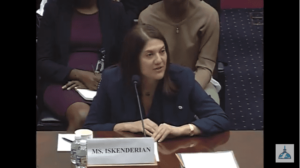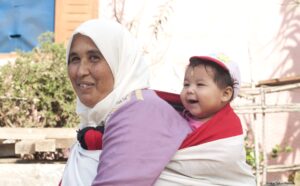Originally posted on July 17, 2017
A note from Women’s World Banking:
On July 12, 2017, Mary Ellen testified in front of the United States’ House Committee on Foreign Affairs hearing entitled “Beyond Microfinance: Empowering Women in the Developing World.”
We’re reposting her prepared testimony because even though more than a year has passed, it is just as relevant. The market potential of the nearly 1 billion unserved women is increasingly threatened by political, economic and physical insecurity.
However we at Women’s World Banking are working hard to chip away at this problem in our collaborations with financial service providers and policymakers across the emerging markets who, unlike many in the sector, have “seen the light” and are committed to closing the gender gap in financial inclusion and realizing the benefits of doing so in their bottom-line and driving growth more broadly in the economy.

But Women’s World Banking can’t do this alone. The Global Findex tells us that 1.1 billion women – more than half of the world’s unbanked population — do not have an account at a bank, while hundreds of millions more do not have access to the full set of financial products. In addition, women own roughly one-third of the 200 million businesses in emerging economies that have no or insufficient access to credit. Providing these women with basic financial services– that fundamental first step toward economic empowerment — can unlock unprecedented economic growth and job creation and can have a direct impact on development outcomes such as health, education, food security, and water and sanitation.
 Women spend, save and invest money in profoundly different ways than men. One such difference: when women have discretion over their financial choices, they prioritize spending on their families. On average, women spend 90 cents out of every dollar earned on education, health care, and housing, in comparison to men’s 60 cents. Improving a woman’s financial access brings with it a “multiplier effect” that will be critical to realizing the potential of financial inclusion for reducing poverty and driving economic17 growth.
Women spend, save and invest money in profoundly different ways than men. One such difference: when women have discretion over their financial choices, they prioritize spending on their families. On average, women spend 90 cents out of every dollar earned on education, health care, and housing, in comparison to men’s 60 cents. Improving a woman’s financial access brings with it a “multiplier effect” that will be critical to realizing the potential of financial inclusion for reducing poverty and driving economic17 growth.
I’m pleased to note that you have entitled this hearing “Beyond Microfinance.” The traditional microfinance institutions established an important principle: low-income people – and women in particular — can borrow responsibly. But over the years we’ve learned that, like all of us, low- income people have complicated financial lives that require more than just a “one size fits all” microloan. Fortunately, a broad range of providers, including mainstream commercial banks and insurance companies as well as payments providers, mobile network operators and fintech companies has emerged to meet these needs.
Yet low-income women face a number of barriers that hinder their access to these services; I’ll touch briefly on just three of them along with some potential solutions. First, millions of women lack the documentation and other forms of identification to open even a simple savings account. India has recently implemented an innovative biometric ID system that has dramatically expanded access to financial services. Elsewhere, tiered “Know Your Customer” requirements allow women to open “no frills” savings accounts with minimal documentation.
The second barrier women face is a lack of collateral. Women generally have fewer assets to pledge to a bank and in many countries are legally barred from owning or inheriting land. In response, some countries have established moveable collateral registries that better reflect the types of assets women can provide to satisfy bank requirements.
Finally, more than 1.7 billion women in low and middle-income countries do not even own a cell phone. This lack of access to technology combined with lower financial and digital literacy prevents them from fully utilizing digital financial services. Once women gain access to their own phones and some basic training, however, their usage levels parallel men’s.
Despite these barriers, I am optimistic about the opportunities presented by women’s financial inclusion. The United States can play an important role in accelerating those opportunities by joining other developed countries that are investing in women’s financial inclusion, often led by their country’s Gender Ambassadors. The United States can use its influence at the G20 and other fora to push for implementation of more national financial inclusion strategies that have explicit gender targets. USAID, OPIC and even ExIm could catalyze more private sector investment by including requirements in their programs to serve women. They could also engage in public-private partnerships that serve to “de-risk” private sector investment.
Distinguished committee members, thank you for calling attention to the role that women’s financial inclusion plays in building stronger families, communities and economies.




